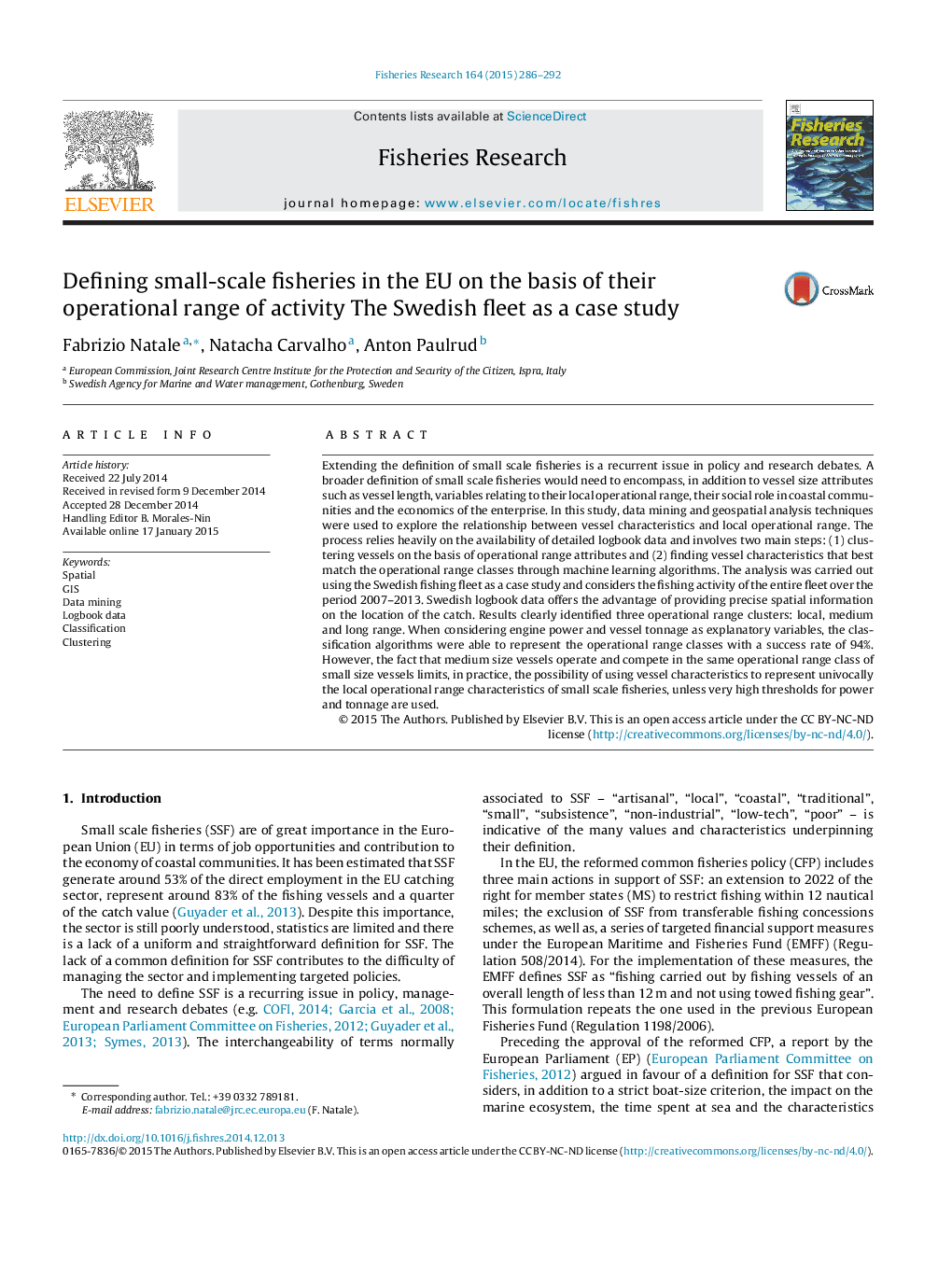| کد مقاله | کد نشریه | سال انتشار | مقاله انگلیسی | نسخه تمام متن |
|---|---|---|---|---|
| 6385723 | 1626804 | 2015 | 7 صفحه PDF | دانلود رایگان |
عنوان انگلیسی مقاله ISI
Defining small-scale fisheries in the EU on the basis of their operational range of activity The Swedish fleet as a case study
ترجمه فارسی عنوان
تعریف ماهیگیری کوچک مقیاس در اتحادیه اروپا بر اساس محدوده عملیاتی فعالیت آنها ناوگان سوئد به عنوان نمونه مورد مطالعه
دانلود مقاله + سفارش ترجمه
دانلود مقاله ISI انگلیسی
رایگان برای ایرانیان
کلمات کلیدی
ترجمه چکیده
گسترش تعریف ماهیگیری کوچک مقیاس یک موضوع مجدد در بحث های سیاسی و تحقیق است. تعریف گسترده ای از شکار ماهی کوچک باید شامل ویژگی های اندازه کشتی مانند طول کشتی، متغیرهای مربوط به محدوده عملیاتی محلی، نقش اجتماعی آنها در جوامع ساحلی و اقتصاد سازمانی باشد. در این مطالعه، به منظور بررسی رابطه بین ویژگی های کشتی و محدوده عملیاتی محلی، داده های معدن و تکنیک های تجزیه و تحلیل جغرافیایی مورد استفاده قرار گرفت. این فرایند به شدت بر روی دسترسی به داده های اطلاعات مربوط به اطلاعات کشتی و به دو مرحله اصلی بستگی دارد: (1) خوشه بندی کشتی ها بر اساس ویژگی های دامنه عملیاتی و (2) پیدا کردن مشخصات کشتی که به بهترین وجه با کلاس های عملیاتی با الگوریتم های یادگیری ماشین مطابقت دارند. این تجزیه و تحلیل با استفاده از ناوگان ماهیگیری سوئد به عنوان مورد مطالعه انجام شد و فعالیت ماهیگیری کل ناوگان در طول دوره 2007-2013 را در نظر گرفته است. اطلاعات روزنامه سوئدی مزیت ارائه اطلاعات فضایی دقیق در مورد محل گرفتن را ارائه می دهد. نتایج به وضوح سه خوشه محدوده عملیاتی را مشخص می کند: محدوده محلی، متوسط و بلند. با توجه به متغیرهای توضیحی در مورد قدرت موتور و تونل کشتی، الگوریتم های طبقه بندی توانستند طبقه های عملیاتی را با میزان موفقیت 94 درصد نشان دهند. با این حال، این حقیقت که کشتی های متوسط دارای فعالیت و رقابت در یک محدوده عملیاتی محدوده ی عروق کوچک هستند، در عمل، امکان استفاده از ویژگی های کشتی برای نشان دادن ویژگی های محدوده عملیاتی محلی ماهیگیری کوچک مقیاس، مگر اینکه آستانه های بسیار زیاد برای قدرت و تناژ استفاده می شود.
موضوعات مرتبط
علوم زیستی و بیوفناوری
علوم کشاورزی و بیولوژیک
علوم آبزیان
چکیده انگلیسی
Extending the definition of small scale fisheries is a recurrent issue in policy and research debates. A broader definition of small scale fisheries would need to encompass, in addition to vessel size attributes such as vessel length, variables relating to their local operational range, their social role in coastal communities and the economics of the enterprise. In this study, data mining and geospatial analysis techniques were used to explore the relationship between vessel characteristics and local operational range. The process relies heavily on the availability of detailed logbook data and involves two main steps: (1) clustering vessels on the basis of operational range attributes and (2) finding vessel characteristics that best match the operational range classes through machine learning algorithms. The analysis was carried out using the Swedish fishing fleet as a case study and considers the fishing activity of the entire fleet over the period 2007-2013. Swedish logbook data offers the advantage of providing precise spatial information on the location of the catch. Results clearly identified three operational range clusters: local, medium and long range. When considering engine power and vessel tonnage as explanatory variables, the classification algorithms were able to represent the operational range classes with a success rate of 94%. However, the fact that medium size vessels operate and compete in the same operational range class of small size vessels limits, in practice, the possibility of using vessel characteristics to represent univocally the local operational range characteristics of small scale fisheries, unless very high thresholds for power and tonnage are used.
ناشر
Database: Elsevier - ScienceDirect (ساینس دایرکت)
Journal: Fisheries Research - Volume 164, April 2015, Pages 286-292
Journal: Fisheries Research - Volume 164, April 2015, Pages 286-292
نویسندگان
Fabrizio Natale, Natacha Carvalho, Anton Paulrud,
